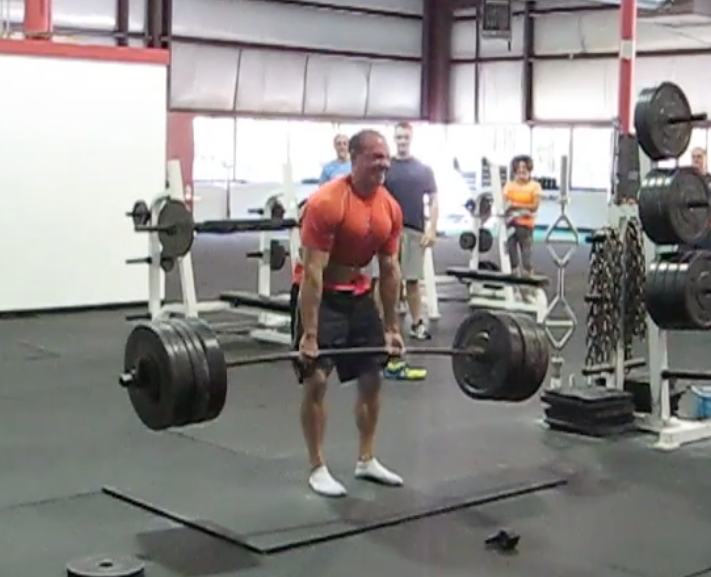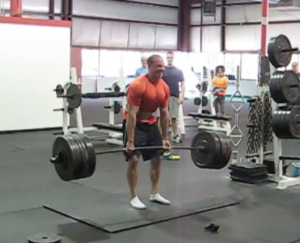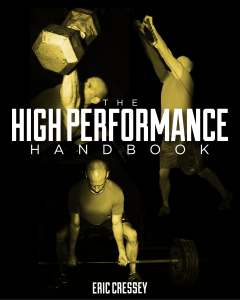
Get Strong by Learning from My Strength and Conditioning Mistakes
We bought our dog, Tank, in October of 2010 – and he’s since gone on to be not only man’s best friend around the house, but also an integral (and entertaining) part of the Cressey Sports Performance experience, as he comes to the gym with me just about every day.
In spite of Tank’s affinity for flashing people, he managed to win adoration of the family of one of our CSP athletes to the point that they decided they wanted to get a cream puggle just like him. Having spent months housetraining him and trying to get him to sleep through the night back in the day, my wife and I had plenty of suggestions for these folks to avoid making the mistakes we made. I mean, we never told him to eat paint chips, but puppies will be puppies, you know?
Anyway, that family is now all settled with their puppy, and it got me to thinking about the importance of learning from others’ mistakes is in the world of strength and conditioning programs. If I can help out one puppy owner, I might as well help out the thousands of visitors on this website each month! With that in mind, here are five strength and conditioning mistakes I corrected that have made a big difference for me:
1. Eating like a sissy in the post-training window – If you’re an up-and-coming lifter or athlete who can benefit from increasing muscle mass (and I definitely was), the post-workout period is not a time when you can skimp on calories. I really did not start making great progress until I was getting in over a thousand calories between my post-training shake and the meal that took place an hour later – and that was on the light side compared to what I’ve seen with some other guys. I can’t think of many things that drive me crazier than seeing one of our athletes finish a training session – and then sit around in the office for 2-3 hours without eating anything. I love having them hang out at the gym, but I just want them to do it with calories!
2. Not training for strength soon enough – I’m going to dumb getting bigger down as much as I can, yet still keep it mathematical. You’ve got to do “muscular damage” and then rebuild. If you don’t do work, you don’t get damage. Work = Force x Distance
Unless you plan on growing for the rest of your life (or find magical ways to keep adding range of motion to exercises), the easiest way to positively impact the amount of work you do is to apply more force – or be stronger. To that end, I’ll make a bold statement here: for the first two years of lifting, your primary goal should simply be to add weight to the bar (provided you can do so in good technique and without pain). As long as we’re talking about compound strength exercises, you’ll be very pleased with the results. We have novice lifters at Cressey Performance who grow like weeds in their first two years of training with us – and I can’t say that I’ve ever had someone ask me about “the pump.” I wish I’d had someone to tell me to shut up when I asked about it when I was 18!
3. Spending too much time doing non-essentials – This one goes hand-in-hand with the previous observation. I really had no place doing curls, triceps extensions, and other isolation exercises when I hadn’t even come close to putting up good numbers on the important strength exercises. It kept me in the gym too long and interfered with my recovery on the really important stuff. The funny thing is that now that I have gotten a lot stronger, I really don’t have interest in doing much of the isolation stuff anymore – because I realize that the core strength exercises are the ones that really helped me progress.
4. Not being more athletic with my energy systems work – Growing up, I was an avid soccer and tennis player, and as a result of all my time on the field/court, I was reasonably quick and good with changes of direction. When my early 20s rolled around, I took a step back from those sports to pursue strength training “full time.” A few years later, I was invited to play in a charity basketball game against a bunch of at-the-time Patriots players like Ellis Hobbs, Reche Caldwell, Pierre Woods, and Logan Mankins (among others). Don’t let anyone tell you that NFL guys can’t play hoops, because these guys mopped the floor with us. The outcome wasn’t altogether surprising, but one thing that did open my eyes was how I just didn’t feel as athletic as I used to be in spite of the fact that I’d gotten a lot stronger as compared to my high school years. I was putting force into the ground, but I wasn’t applying it quickly – and I wasn’t doing it in planes of motion in which I was comfortable. Not surprisingly, most of my energy systems work at the time (which really wasn’t much) was being done on machines: ellipticals, versa-climbers, rowers, and bikes. I committed to cutting back on mindless repetitive motion cardio right away – and since then, just about all my energy systems work has been sprinting, strongman-type medleys, change of direction work, slideboard work, and medicine ball circuits (plus just a small amount of Airdyne work). The end result? A 37.2-inch vertical jump – more than 12 inches better than I was back at the time, and I’m at a higher body weight and just as lean as when I was doing all that “gerbil cardio.” More importantly, I feel a ton more athletic – and I’m more likely to do stupid things for others’ amusement around the gym.
5. Not finding a good training crew earlier – I’ve been fortunate to lift with some excellent training partners, from my days on-campus at the University of Connecticut, to South Side Gym, to the guys I lift with at Cressey Sports Performance nowadays. Before that, though, I was flying solo for quite some time. Let me tell you: good training partners make a HUGE difference. They pick you up when you’re dragging, help you select weights, provide spots/handoffs, and create an awesome social atmosphere that actually helps training progress. “Going it alone” doesn’t just refer to having training partners with whom you can lift, though. It also refers to having professional resources to whom you can turn – whether it’s a massage therapist when your elbows get cranky from all the gripping you do, or someone to help you out with your strength and conditioning programs. I’m not going to lie: I did some terrible programs back in the day when I didn’t know any better. If I’d had an unbiased party helping me out, I could have saved myself a lot of trouble. That’s one reason why I created The High Performance Handbook.
On one hand, it takes the guesswork out of training by providing the actual strength and conditioning programs as well as an extensive video database to help with technique on all the mobility and strength exercises. On the other hand, though, I designed it so that it would give folks a lot of wiggle room when it comes to adapting it to their unique goals and needs. It starts with an easy-to-apply assessment you can use to determine your unique needs. From there, you’ve got 4x/week, 3x/week, and 2x/week strength training programs; different supplemental conditioning options; and a unique mobility warm-up for every month of the program. Problems solved. Click here to learn more about The High Performance Handbook.





